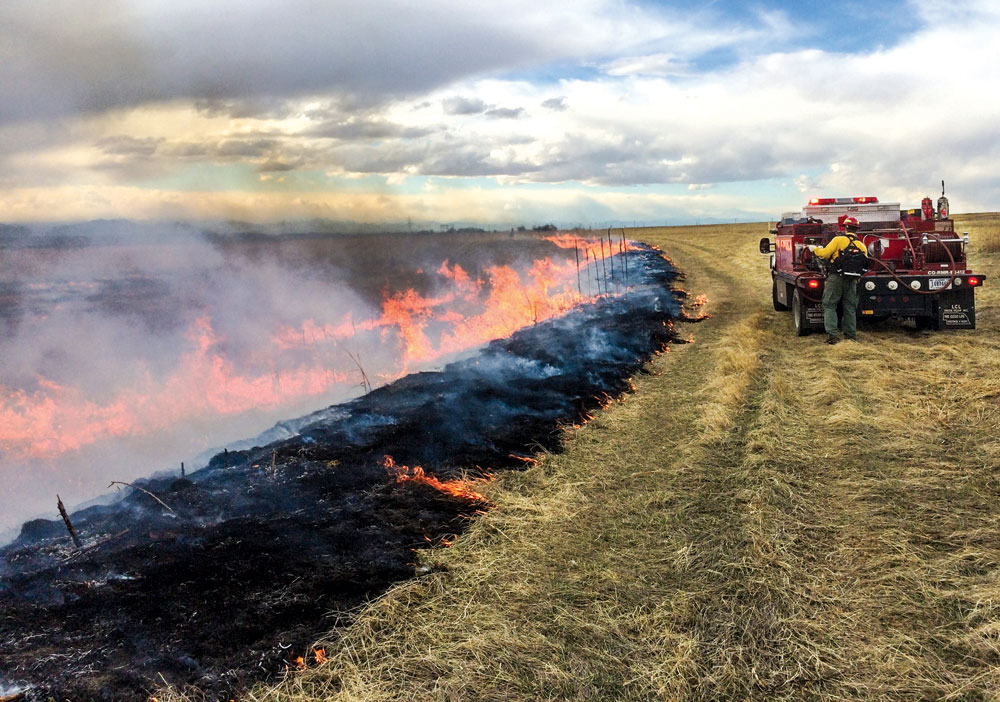
In many Central Park neighborhoods, close-knit homes are directly adjacent to open space grasslands. These wildland-urban interface areas pose unique risks for wildfire. Front Porch photo by Christie Gosch
Last year’s devastating Marshall fire, which raced across open-space grasslands and destroyed more than 1,000 homes in Boulder County, has led many homeowners to question whether a similar disaster could happen in Central Park. The Marshall fire, fueled by unusually dry weather and coupled with wind gusts over 100 miles per hour, quickly consumed the dense housing that surrounded the open space areas.
Sarah Metzer, with the Rocky Mountain Arsenal National Wildlife Refuge, said it was a perfect storm of conditions and—although extremely rare—could happen again.
“With those down-sloping winds, I’m not sure you could realistically combat that fire—even with all of the resources available. And therein lies the tragedy, knowing that there might not have been any way to have prevented this.”
The nearly 16,000-acre wildlife refuge is directly adjacent to densely-crowded homes in the northern part of Central Park. That wildland-urban interface, where housing and businesses intermingle with undeveloped lands, can pose unique risks for wildfire.

Land managers at the Rocky Mountain Arsenal Wildlife Refuge use prescribed burns to eliminate fuel and prevent large wildfires. Photo courtesy of USFWS
Metzer says the employees at the refuge take those risks very seriously. Half of the staff have firefighting training, a Type 6 wildland fire engine is kept on the property, and the U.S. Fish and Wildlife Service keeps an inter-agency fire management team stationed at the refuge to respond to regional fires. In addition, the refuge follows a comprehensive land management plan that includes a variety of strategies including the removal of invasive grasses and prescribed burns to help reduce the fuel load. Metzer says the prescribed burns are one of the pillars of being a good community neighbor.
“It wouldn’t be responsible of us to allow so much fuel to accumulate.”
The prescribed burns are usually conducted in early spring and are highly coordinated across several agencies to ensure public safety.
“A lot of planning goes into these burns to make sure they’re conducted in a safe manner. Weather conditions have to be absolutely correct, and there can’t be too many clouds that would entrap smoke,” says Metzer.
But the wildlife refuge isn’t the only open space where fire is a concern. More than 1,000 acres of open grasslands snake through the Central Park neighborhood along Sand Creek and Westerly Creek. Those lands are managed by Denver Parks and Recreation (DPR), which does not conduct prescribed burns. Officials there declined to be interviewed for this story, but sent an email which said, “the majority of Denver is rated at ‘low’ to ‘no risk’ for wildland-urban interface fires. DPR has re-evaluated the open space management practices for the urban park system and confirmed, at this time, no changes are required regarding our current work plan and mowing procedures.”
Those procedures include: maintaining native grasses, managing noxious weeds and retaining taller grasses “that hold moisture in the soil and keep plants from becoming dry earlier in the season.” The department also provides outreach to residents on “best ecological practices by providing plant species recommendations and landscaping alternatives.”
The Denver Fire Department can also provide resources to homeowners about best ways to prevent wildfires in the wildland-urban interface. Captain Greg Pixley said trees and bushes shouldn’t be planted next to houses, dead branches should regularly be removed, and limbs of evergreen trees should be cut at least six feet up from the ground. He also said it’s critical to keep roof gutters clean. “Gutters collect dry needles and leaves, and if an ember blows in, it can catch fire and quickly spread.”
Metzer agrees that residents have a big role to play and cited studies that show that the majority of wildfires since the mid-1990s have been caused by humans. She said people need to be responsible with barbecues and cigarettes and that people should avoid illegal fireworks and storing flammable items under decks or next to their house.
Fire captain, Pixley, says that just 25 days before the Marshall fire, residents of Northeast Denver had their own scare when a wildfire burned seven acres of open-space grasses in the Lowry neighborhood.
“Fortunately, fire crews were on the scene within five minutes and were able to surround it and put the fire out without any structures being affected. But this was a classic situation where things could have quickly gotten much worse.” The cause of that fire was never determined.
For more information wildlife preparedness visit https://www.wildlandfirersg.org/s/are-you-wildfire-ready?language=en_US




0 Comments